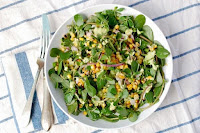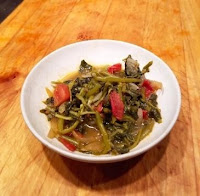
Purslane is an opportunistic plant and grows in nearly every country in the world. It has been cultivated for over 4000 years both for food and for its medicinal qualities. It is easily identified by its prostrate habit and succulent-like leaves that resemble those of a miniature Jade plant; about fingernail sized. The stems are reddish and radiate from a central point. The side stems can also root, so there may be several radians in the same plant. The taste is described as slightly tart, salty, and similar to spinach or watercress. Believe it or not, it has been found to have more beneficial nutrients than most vegetables! It is described as a "superfood" and one of the most nutritious foods on the planet.
There are some great ways to use this superfood in your kitchen. The leaves and stems are edible and can be prepared in many ways, both raw and cooked. But remember, as with all vegetables you eat, ensure that the product is clean and free from pesticides or herbicides. Give this “weed” a place on your table at least once and try it. Remember, if you can’t beat ‘em, eat ‘em! Especially when they are so good for you! While an internet search will yield many recipes, following are a couple I have prepared and enjoyed.









